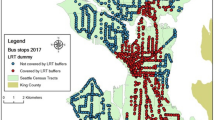Abstract
Mass transit projects are often a top contender of many cities to meet their increasing demand for travel. Despite the global trend of privatization, mass transit services, as public goods, remain largely being provided and operated by the public sector. Hong Kong is one of the few exceptions that all mass transit services are commercially operated. Both rail and bus services in Hong Kong are reputable for their quality and profitability, often serving as benchmarks for new projects. In this study, we investigate the factors contributing to this success. In particular, we ascertain the quality of transit service provision by the private sector over the past two decades. Then, we conduct an in-depth analysis of the account books of leading railway and bus operators in Hong Kong so as to shed light on their financial viability. Through this study, we hope to present crucial factors for providing financially viable private transit services.



Similar content being viewed by others
Notes
MTR was privatized and became a listed company in October 2002.
Abbreviations
- HCM:
-
Highway Capacity Manual
- KCR:
-
Kowloon Canton Railway
- KMB:
-
Kowloon Motor Bus
- MTR:
-
Mass Transit Railway
- PCS:
-
Profit Control Scheme
- pcu:
-
passenger car unit
- phpd:
-
per hour per direction
- TKO:
-
Tseung Kwan O
References
Barron, B., Ng, S., Kwok, V.: Financing mass transit railways: an international survey, Hong Kong (2001)
Barron, B., Ng, S., Ho, B., Chan, C.: West Island Line/South Island Line: direct external benefits. Hong Kong (2004)
Bowes, D.R., Ihlanfeldt, K.R.: Identifying the impacts of rail transit stations on residential property values. J. Urban. Econ. 50, 1–25 (2001)
Census and Statistics Department, Government of the Hong Kong special administrative region: Hong Kong Annual Digest of Statistics (2004)
Chau, K.W., Ng, F.F.: The effects of improvement in public transportation capacity on residential price gradient in Hong Kong. J. Prop. Valuat. Invest. 16(4), 397 (1998)
Dowling, R.: National cooperative highway research program report 387–Planning technique to estimate speeds and service volumes for planning applications. National Academy Press, Washington (1997)
Dowling Associates: National cooperative highway research program 3-55(2)A—planning applications for the year 2000 highway capacity manual: appendix a literature review. Transp. Res. Board (1999)
Economic Development and Labour Bureau: Government of the Hong Kong special administrative region: study of the auto-fuel retail market (2005)
Environment Branch: Government secretariat of Hong Kong: keeping hong kong moving: the white paper on internal transport policy (1979)
General Accounting Office: (United States): Mass transit—bus rapid transit shows promise (2001)
Kain, J.F., Liu, Z.: Secret of success: assessing the large increases in transit ridership achieved by Houston and San Diego transit providers. Transp. Res. Part A 33, 601–624 (1999)
Kowloon Canton Railway Corporation: annual report (2004)
Kowloon Motor Bus (1933) limited: annual report (2000–2005)
Levinson, H., Zimmerman, S., Clinger, J., Rutherford, S., Smith, R.L., Cracknell, J. and Soberman, R.: Transit cooperative research program report 90 volume 1: case studies in bus rapid transit. United States Transp. Res. Board (2003)
Liu, J., Hwang, C.: Analysis of property prices before and after the opening of the Taipei subway system. Ann. Reg. Sci. 38(4), 687–704 (2004)
Mackett, R.L., Edwards, M.: The impact of new urban public transport systems: will the expectations be met. Transp. Res. Part A 32, 231–245 (1998)
Mass Transit Railway Corporation Limited: annual report (2000–2005)
McMillien, D., McDonald, J.: Reaction of home prices in a new rapid transit line: Chicago’s midway line 1983–1999. Real Estate Econ. 32(3), 463–486 (2004)
Nelson, P., Baglino, A., Harrington, W., Safirova, E., Lipman, A.: Transit in Washington, DC: current benefits and optimal level of provision. J. Urban Econ. 62, 231–251 (2007)
Pucher, J.: Urban passenger transport in the United States and Europe: a comparative analysis of public policies–part 1: travel behavior, urban development and automobile use. Trans. Rev. 15(2), 99–117 (1995)
Roger, G. and Patient, J.: Competition in the public transport sector and on toll road. Civic Exchange, 2003
Sislak, K.G.: Bus rapid transit as a substitute for light rail transit: a tale of two cities. paper presented at the 8th apta/trb joint conference on light rail transit, November 2000
Stephen, G., Stephen, M.: Valuing rail access using transport innovations. J. Urban Econ. 57(1), 148–169 (2005)
Suen, W., Tang, B.: Optimal site area for high density housing development. Habitat Int. 26(4), 539–553 (2002)
Tang, S., Lo, H.: The impact of public transport policy on the viability and sustainability of mass railway transit–the Hong Kong experience. Transp. Res. Part A 42, 563–576 (2008)
Transport Branch: Hong Kong Government: moving into the twenty-first century: the white paper on transport policy in Hong Kong (1990)
Transport Bureau: Government of the Hong Kong special administrative region: Hong Kong moving ahead (1999a)
Transport Bureau: Government of the Hong Kong special administrative region: legislative council brief: mass transit railway bill (1999b)
Transport Bureau: Government of the Hong Kong special administrative region: railway development strategy (2000)
Transport Department: Government of the Hong Kong special administrative region: third comprehensive transport study final report (1999)
Transport Department: Government of the Hong Kong special administrative region: travel characteristics survey 2002 final report (2003)
Transport Department, Government of the Hong Kong special administrative region: annual transport digest (1995–2005)
Transport and Housing Bureau: Government of the Hong Kong special administrative region: legislative council paper no. CB(1)1999/07-08(1) (2008)
Wright, L.: Bus rapid transit—sustainable transport: a sourcebook for policy-makers in developing cities (2003)
Yiu, C.Y., Wong, S.K.: The effects of expected transport improvements on housing prices. Urban Stud. 42(1), 113–125 (2005)
Acknowledgment
The constructive comments from the anonymous referees and the Editor are gratefully acknowledged. The study was partially supported by the Competitive Earmarked Research Grant #617105 from the Research Grants Council of the Hong Kong Special Administrative Region.
Author information
Authors and Affiliations
Corresponding author
Rights and permissions
About this article
Cite this article
Tang, S.B., Lo, H.K. On the financial viability of mass transit development: the case of Hong Kong. Transportation 37, 299–316 (2010). https://doi.org/10.1007/s11116-009-9251-7
Published:
Issue Date:
DOI: https://doi.org/10.1007/s11116-009-9251-7




